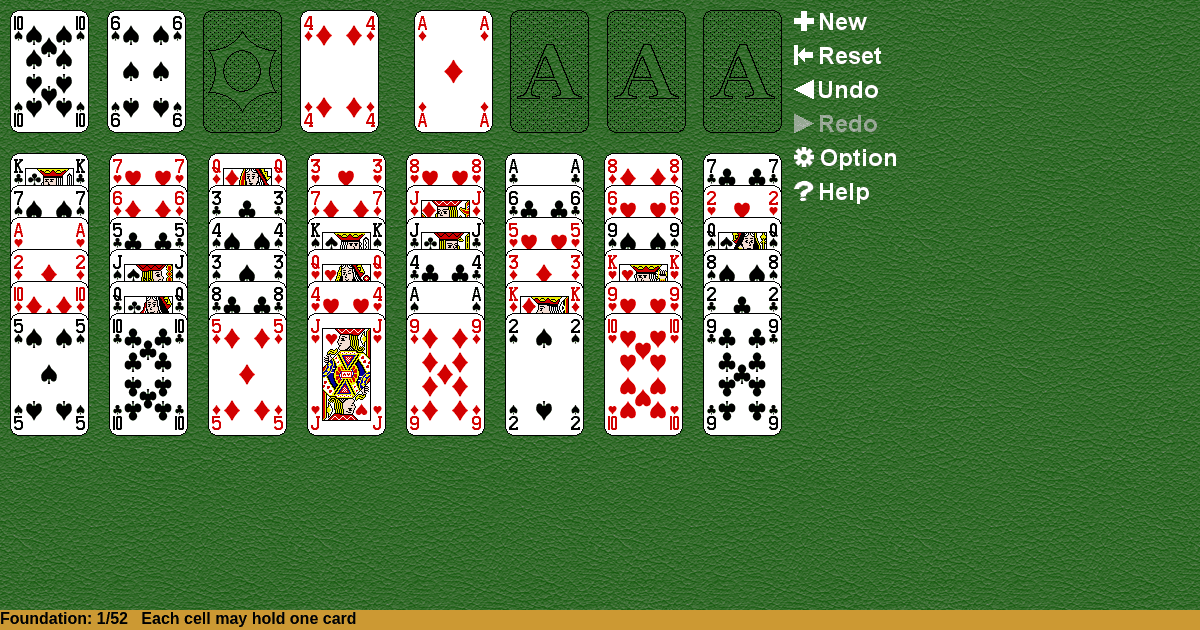ForeCell
Home |
How to play |
FAQ |
About
How to play ForeCell?
Game Objective:
The primary goal in ForeCell Solitaire is to move all cards from the tableau to the four foundation piles, building each foundation up in ascending order from Ace to King, by suit.
Setup & Layout:
- Deck: ForeCell Solitaire uses a standard 52-card deck.
- Initial Deal: All 52 cards are dealt face-up into eight tableau columns of approximately equal length (typically four columns with seven cards and four columns with six cards).
- Key Play Areas:
- Tableau: The main play area, consisting of eight columns where cards are arranged in descending order and alternating colors.
- Foundations: Four piles, one for each suit, where cards are built up from Ace to King.
- Cells (Free Cells): Four single-card holding spaces used to temporarily store cards.
- Card Orientation: All cards are dealt and remain face-up throughout the game, ensuring full visibility of the tableau.
ForeCell Solitaire Rules:
- Card Movement Principles:
- Only the top card of each tableau column or a card in a free cell may be moved at any time.
- Cards can be moved to:
- A foundation pile (if it is the next in sequence and of matching suit).
- Another tableau column (if it follows the descending order and alternates color).
- A free cell (if there is an empty cell available).
- Building Sequences:
- On the Tableau: Build down in rank and alternate colors (e.g., red 7 on black 8).
- On the Foundations: Build up by suit from Ace to King (e.g., Ace, 2, 3, … King of Hearts).
- Moving Multiple Cards:
- You may move a sequence of cards as a unit within the tableau, but only if there are enough empty free cells and/or empty tableau columns to facilitate the move.
- The maximum number of cards that can be moved as a sequence is determined by the formula:
[ \text{Max sequence length} = (\text{Number of empty free cells} + 1) \times 2^{\text{Number of empty tableau columns}} ] In standard play, with only free cells considered, the practical rule is:
[ \text{Max sequence length} = \text{Number of empty free cells} + 1 ] For example, with two empty free cells, you may move a sequence of up to three cards together.
Gameplay:
- Turn Actions:
- Move any exposed card from the tableau or a free cell to a foundation, another tableau column, or a free cell, following the movement rules above.
- Move sequences within the tableau if allowed by the number of empty free cells and columns.
- Introducing New Cards:
- There is no stock or reserve; all cards are in play from the start.
- If No Legal Moves Remain:
- The game ends in a loss if no further legal moves can be made and not all cards are in the foundations.
Winning & Losing Conditions:
- Winning Condition: All cards are successfully moved to the four foundation piles, each built up in suit from Ace to King.
- Losing Condition: The game is lost or unwinnable if no legal moves remain and not all cards have been moved to the foundations.
Special Rules & Edge Cases:
- Filling Empty Spaces:
- Empty Tableau Columns: Any card or legal sequence may be moved to an empty tableau column, subject to the sequence movement rules and available free cells.
- Empty Free Cells: Any single card from the tableau may be moved into an empty free cell.
- Restrictions:
- Only one card may occupy a free cell at any time.
- Once a card is placed on a foundation, it cannot be moved back to the tableau or a free cell.
- Only the top card of a tableau column or a card in a free cell is available for play; cards cannot be moved from the middle of a tableau column.
- Sequence Movement Limitation: The length of a movable sequence is strictly limited by the number of empty free cells and empty tableau columns.
- No Hidden Cards: All cards are face-up and fully visible, eliminating uncertainty and emphasizing skill over luck.
Note: While the above rules describe the standard "FreeCell" solitaire, the variant "ForeCell" is not documented in official rulebooks or major solitaire resources as a distinct game. If "ForeCell" refers to a specific house rule or minor variant, please provide additional details for further clarification. The rules above are based on the widely recognized FreeCell solitaire ruleset, which is the closest match according to available sources.

Solitaire Collection
About ForeCell
Rate (ForeCell)
4.7 / 5
1,916 votes



























































